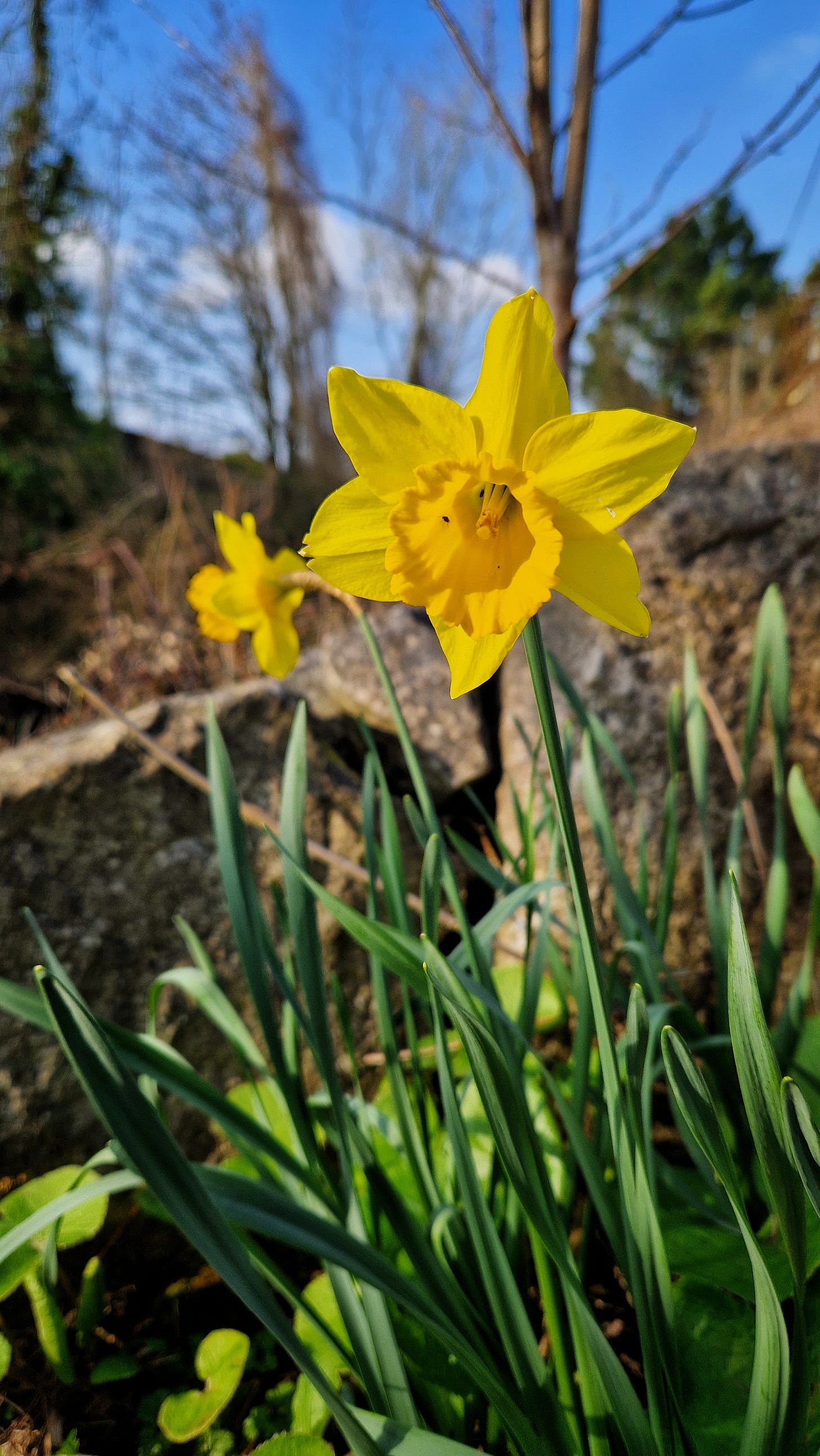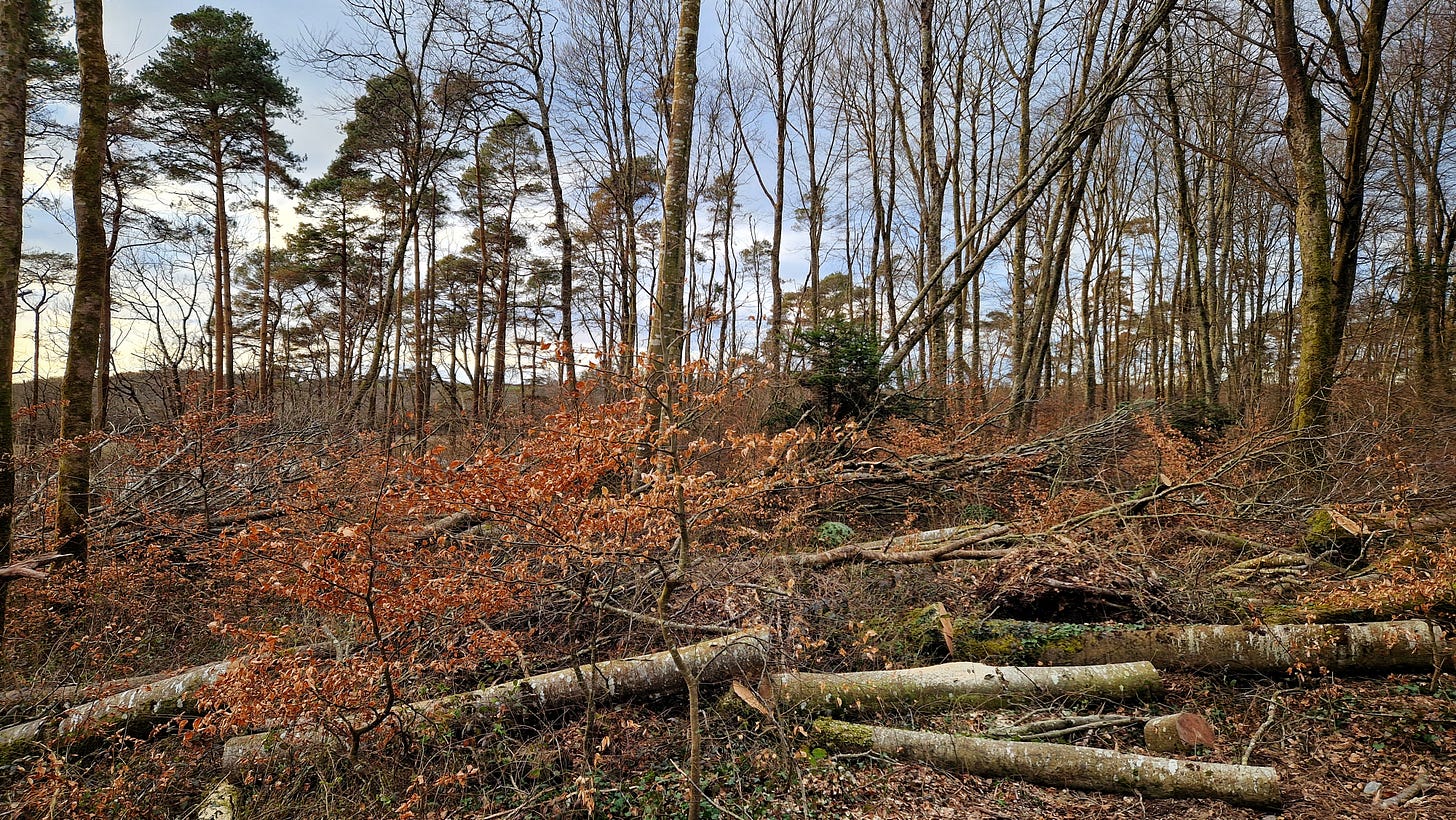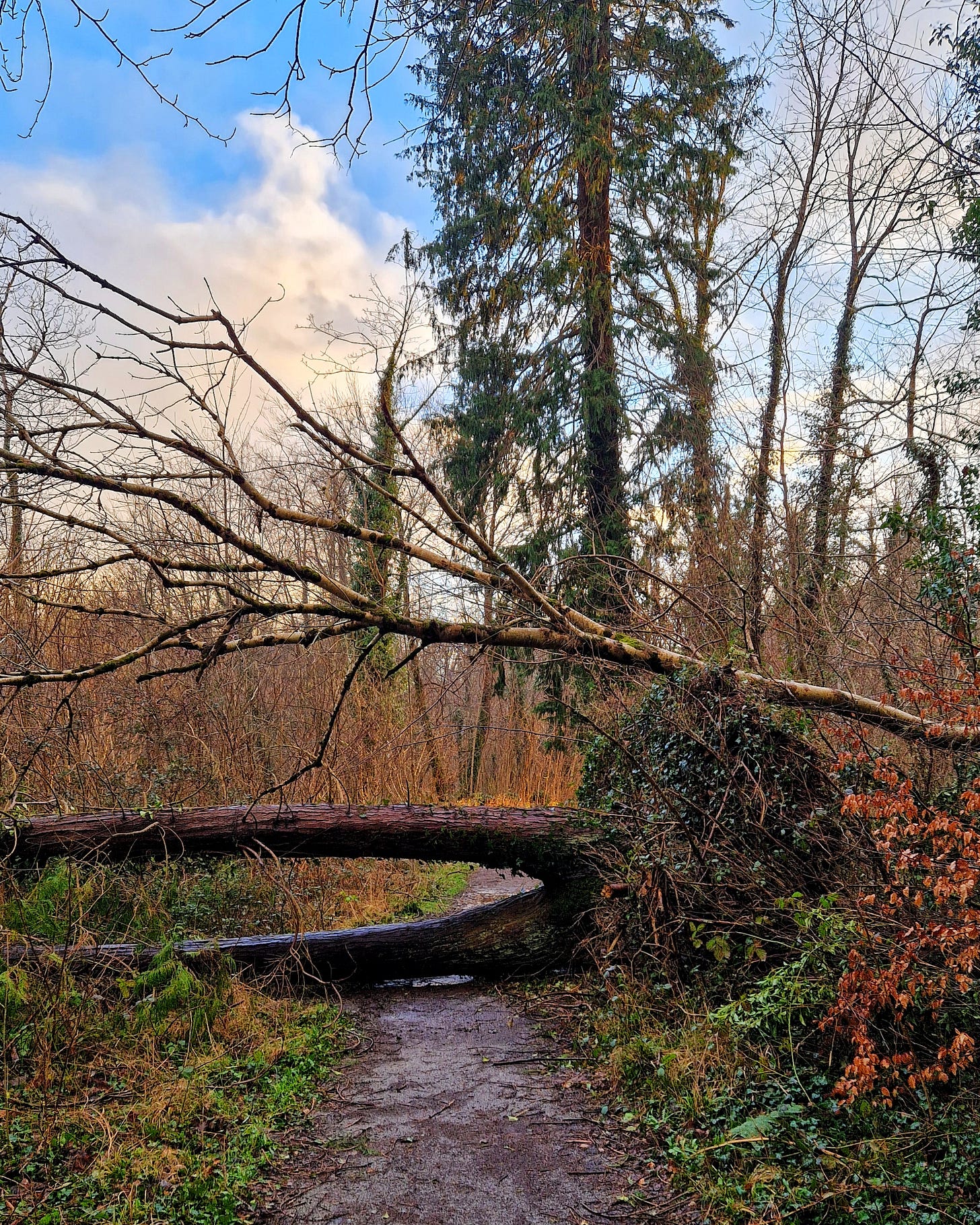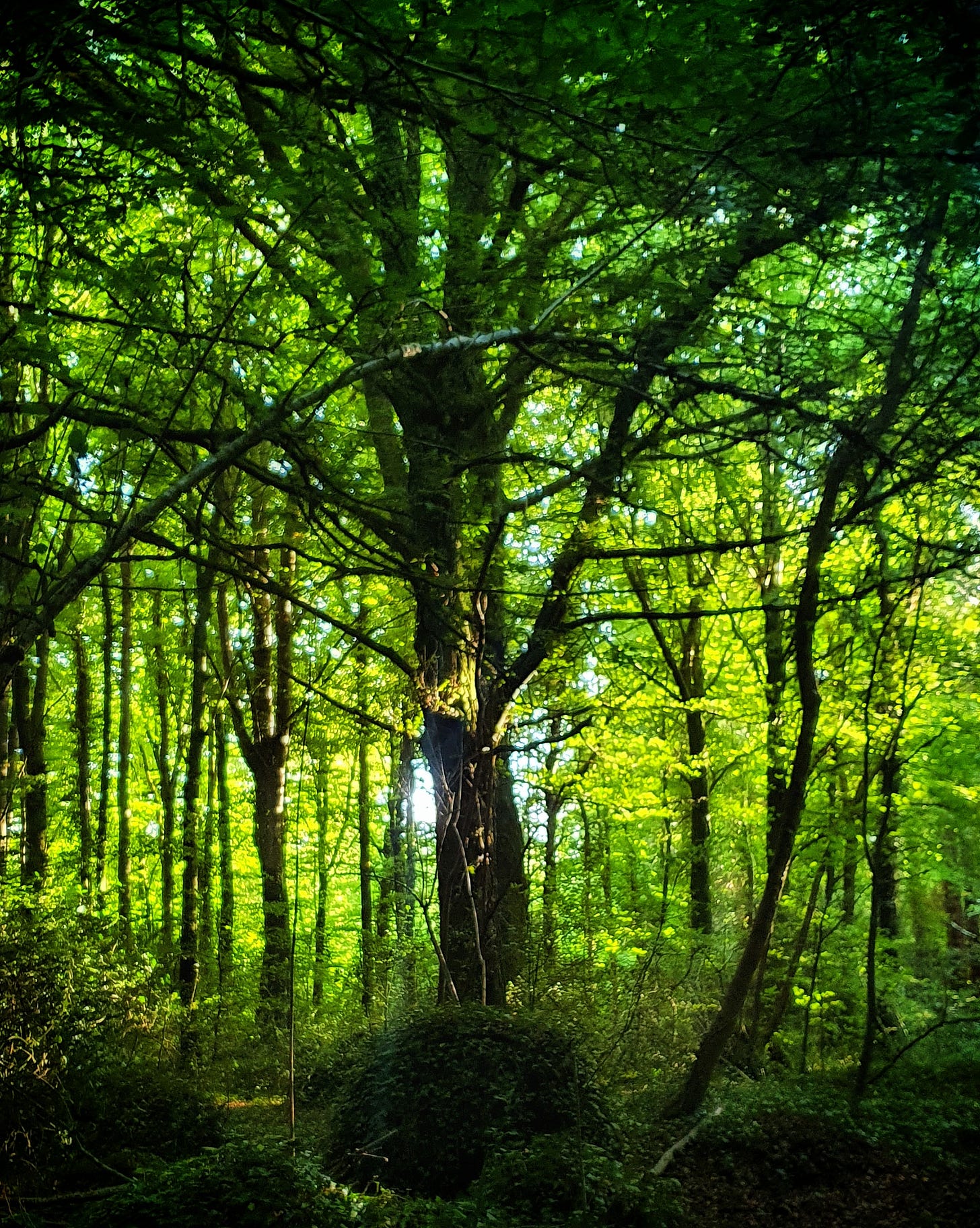Dear word explorer,
I offer you a Spring bouquet from Ireland, taken on a sunny, cold day, as the daffodils trumpeted their bright alarm call and the trees sluggishly began to wake up from their restorative slumber.
Soon, blossoms will foam on every bough.
We are close to the Spring Equinox here in the West of Ireland, which will take place on the morning of the 20th of March this year.
As I explained in a recent newsletter, ‘Stuff and Ghosts’, we are more likely to see Aurora Borealis during the equinoxes, due to the Russell-McPherron Effect, where the Earth’s magnetic field aligns with the solar winds.
Mike Hapgood, the principal consultant on space weather at Rutherford Appleton Laboratory (RAL) Space, explained it for Newsweek:
“During the equinoxes, the orientation of the Earth’s poles is (almost) perpendicular to that of the sun," Beggan said. “This maximizes the ‘coupling’ between the solar wind and the Earth's magnetic field. In summer or winter, one of the Earth’s poles is pointing at an angle from the solar wind so the coupling between them is lower and hence there are fewer storms on average.”
Since we are experiencing Solar Maximum, and our closest star is prone to fling plasma at us regularly during Coronal Mass Ejections (CME), we are even more likely to catch a great light show at this time of the year.
The animist in me loves that the sun and our planet harmonise twice-yearly. Almost like a call-and-response.
‘Marco’ says the Sun. ‘Polo’ says Earth, and gorgeous colours bloom across the night sky to celebrate our energetic communion.
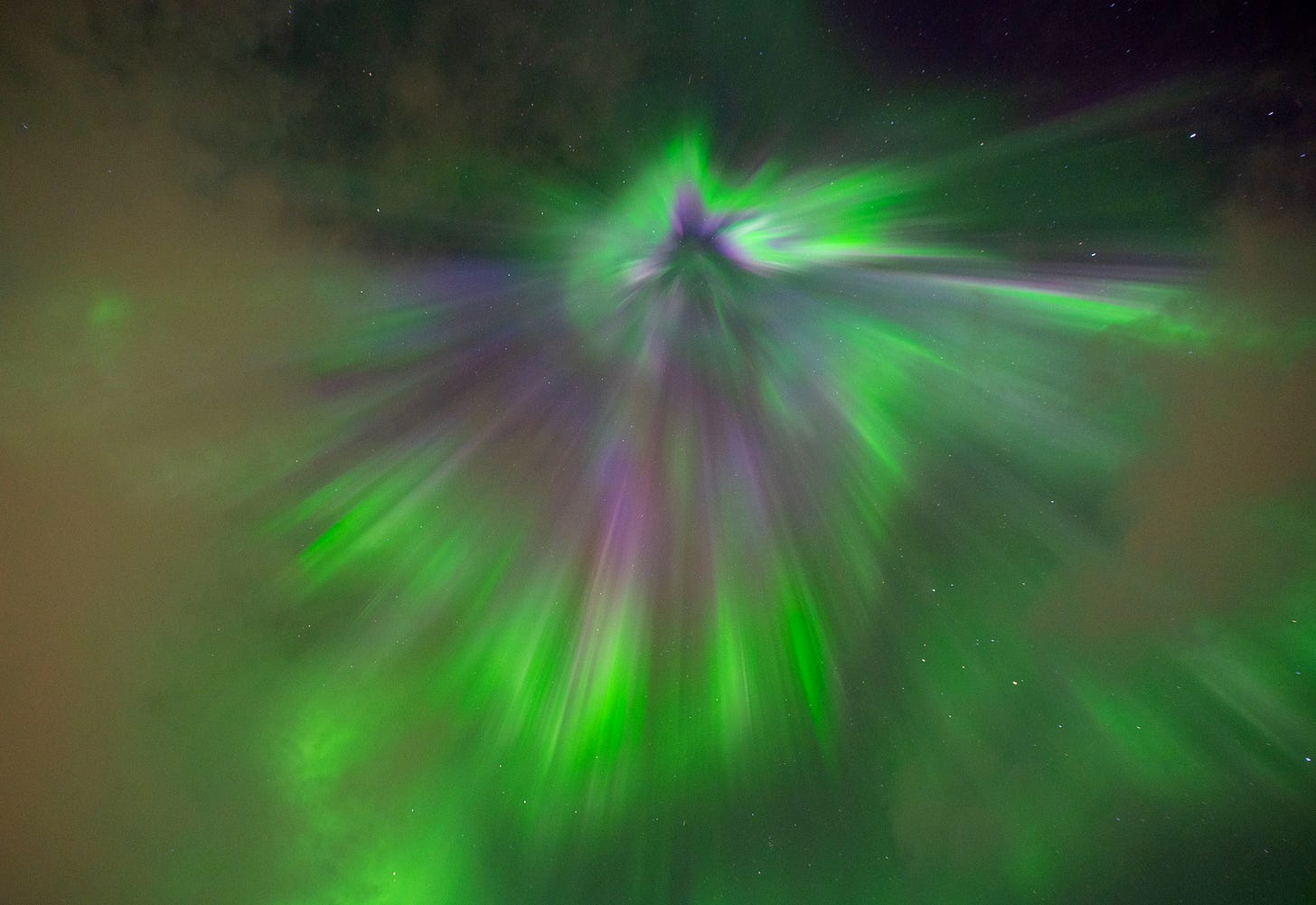
This is the kind of splashy phantasmagoria I would enjoy watching on St. Patrick’s Day — it looks like an Emerald Angel!
An Equinox luminance may be coming, since SpaceWeather reports that a CME should graze Earth's magnetic field on the 20th of March.
Thanks to a streak of fine but chilly weather I’ve been enjoying walks in the woods and by the rivers of my local area. The birds are singing ballads to their nesting mates, green tendrils are twisting up from the frigid mulch, but sadly there are signs everywhere of the devastation of trees caused by Storm Éowyn in late January.
It took several weeks before I could brave going to my favourite places to confront the changes first hand.
In my opinion trees are one of the finest species on the planet. When I was a child I had a strong connection to trees, seeing them as loyal and steadfast landmarks on my daily walks to school. There were several I enjoyed climbing, and under their green, whispering canopies I could rest upon their craggy surface and observe the world unseen. I felt completely supported and safe.1
When I was thirteen I read The Lord of the Rings, and I loved Tolkien’s Ents — the Tree Shepherds — slow talking, never hasty, but capable of furious resistance when roused by betrayal: “Their punches can crumple iron like tin, and they can tear apart solid rock like breadcrusts.” I never regarded trees the same way after reading the books. To me, they were lifeforms waiting to wake up.
The first time I saw an image of a human brain neuron I was struck by its similarity to that of a tree, but I was hardly the first to notice the similarity. There are approximately a hundred billion neurons in the brain, and while they have a resemblance to trees — possessing a trunk (the soma), branches (dendrites) and roots (axonic branches) — neurons are electric relays.
Years later as I continued my reading and interest in trees I discovered that science had caught up with my wonder and love of trees. They are far more complex, social and enriching to our planet than previously imagined.2
This short video offers a useful summary of the vast symbiotic network underneath the forest in which the tree roots are interwoven with mycorrhizal fungal systems to swap nutrients and provide a massive subterranean communication system, fondly referred to as the ‘wood-wide-web’. Trees are ‘super-cooperators’, sending sugars or minerals to those who are unwell or not thriving, and are able to discern which trees are ‘kin’ and to send them extra aid. Trees stricken with disease or insects can alert their fellows of the problem and allow them to switch on defences that can help their survival.
There are important hub trees in the system, referred to as Mother trees, which recognise their offspring and send them extra food to strengthen their development. When I walk in the woods I am mindful of my steps upon this tree/plant/fungal communication system. In my imagination the trees have a 3D holographic view of the forest based on their spatial existence and the feedback from their intelligence below, and when I stroll through it they sense my presence and interaction in their unique fashion. They breathe in my breath.
Pivotal books that help explain this change in thinking about woods and forests come from German forester, Peter Wohlleben, whose 2016 book, The Hidden Life of Trees: What They Feel, How They Communicate, became a bestseller. He started as a typical forester and over decades of observation completely changed his approach to forestry. His aim became to preserve the knowledge of the elder trees and to allow for sustainable logging by sympathetic culling while planting a variety of native trees that are suitable to the climate and the ecosystem.
His observations tallied with the research by Canadian forestry scientist and conservationist, Suzanne Simard, which she detailed in her memoir, Finding the Mother Tree: Uncovering the Wisdom and Intelligence of the Forest. You can watch her excellent TED talk, How Trees Talk to Each Other, if you want a short overview of how she figured out the true marvel of this underground movement.
In the 1980s in Japan, the concept of shinrin-yoku (forest bathing) took hold as a form of natural therapy for urbanised people, to reset and calm their overstimulated nervous systems. It was understood that by connecting to the matrix of the forest, they invited its cooperative spirit to soothe their jangled, discomboulated nerves.
Some of the woodlands I visit are better managed than others, so there are differences in how well the downed trees have been chainsawed and logged. Trees that block routes or are considered a hazard are dealt with quickly, but there are swathes of trees that are toppled further in the stands and lean drunkenly upon their companions, threatening their future. The smell of resin and sawdust lingers in the air.
While mourning the trees that had dropped I tried to remember that some of them may have been weakened already by age or unseen ailments, and that the vast underground mesh was rallying to this crisis. On the surface, trees appear fixed and stately, but underneath, it’s a grid of scintillating conversation and resource management. Nourishment is shared and information is swapped.
Above, within the newly opened spaces, saplings will be racing to fill the gaps and begin the next generation of tree occupation. Trees do not measure time in our fashion, they live so much longer than humans, so my guess is that they have a fortitude and forbearance that might seem unnatural to us.
It’s hard to bear witness to such destruction. To look it at it squarely and feel the loss. It reminded me that humans aren’t very good at this, much of the time. We want to push past the discomfort, the grief, and the void in our lives. We occupy ourselves with errands and work, with distractions and numbing substances. We run from the pain but it dogs us anyway. To fall into the void is frightening — can we return, will we stay there too long? Who knows, everyone grieves differently. Better to accept that dark indwelling period without remonstration or trying to hurry it along. Instead, sit with its heaviness as an old friend and accept it… until it dissipates, as it will.
Every time I’m in the woods I look at the fallen trees, some of which lived hundreds of years, and I consider their contribution to the ecosystem of the place. I also remind myself that the majority of the trees remain standing — where do I wish to focus? I ponder how trees understand rest and recovery better than humans. They have a whole season for sleep and dreaming. They do not set their sap rising until the conditions are right.
I also have no doubt that trees miss those who have been taken from the collective, and are marked by traumatic events, but I also do not doubt that they remember their companions, and they regroup, adapt and eventually thrive again.
Perhaps one day their memory banks will recall the sense of a girl swinging her legs from their branch, her cheek upon their bark, long after I am dust.
I did fall out of a tree once, but it wasn’t my friendly regular, whose sturdy branches I knew so well.
I didn’t even get into how vital they are to the existence of all life on Earth, and most mythologies have stories about trees and their sacred importance to humans. Forests create micro climates that support teeming life: animals, birds, fungus, lichen, moss, plants and insects thrive in these green havens.





